The continuous flow bioreactors market is projected to grow from USD 160.3 million in 2025 to approximately USD 558.8 million by 2035, recording an absolute increase of USD 398.5 million over the forecast period. This translates into a total growth of 248.5%, with the market forecast to expand at a compound annual growth rate (CAGR) of 13.3% between 2025 and 2035.
The overall market size is expected to grow by nearly 3.5X during the same period, supported by increasing demand for advanced biomanufacturing technologies, growing prevalence of biopharmaceutical production, and rising adoption of continuous manufacturing processes across the global biotechnology and pharmaceutical sectors.
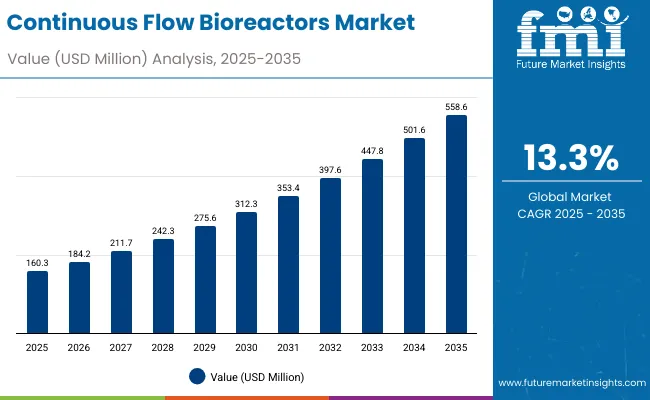
Continuous Flow Bioreactors Market Key Takeaways
| Metric | Value |
|---|---|
| Estimated Value in (2025E) | USD 160.3 million |
| Forecast Value in (2035F) | USD 558.8 million |
| Forecast CAGR (2025 to 2035) | 13.3% |
Between 2025 and 2030, the continuous flow bioreactors market is projected to expand from USD 160.3 million to USD 299.3 million, resulting in a value increase of USD 139.0 million, which represents 34.9% of the total forecast growth for the decade. This phase of development will be shaped by increasing biopharmaceutical production demand, rising adoption of continuous manufacturing processes, and growing utilization in cell and gene therapy applications. Biotechnology companies and pharmaceutical manufacturers are expanding their continuous flow technology capabilities to address the growing preference for efficient and scalable bioprocessing features in bioreactor systems.
From 2030 to 2035, the market is forecast to grow from USD 299.3 million to USD 558.8 million, adding another USD 259.5 million, which constitutes 65.1% of the overall ten-year expansion. This period is expected to be characterized by the expansion of advanced bioprocessing technologies, the integration of AI-powered process control systems for premium continuous flow bioreactor products, and the development of enhanced scalability features for specialized applications. The growing emphasis on personalized medicine and advanced therapeutic development will drive demand for intelligent bioreactor systems with enhanced monitoring capabilities and improved production effectiveness.
Between 2020 and 2024, the continuous flow bioreactors market experienced robust growth, driven by increasing biopharmaceutical industry expansion and growing recognition of continuous manufacturing systems' superior production capabilities across biotechnology and pharmaceutical applications. The market developed as manufacturers recognized the potential for continuous flow bioreactor technology to enhance production outcomes while meeting modern biomanufacturing requirements for scalability and process control. Technological advancement in bioreactor design and process optimization algorithms began emphasizing the critical importance of maintaining production efficiency while extending operational flexibility and improving product quality effectiveness.
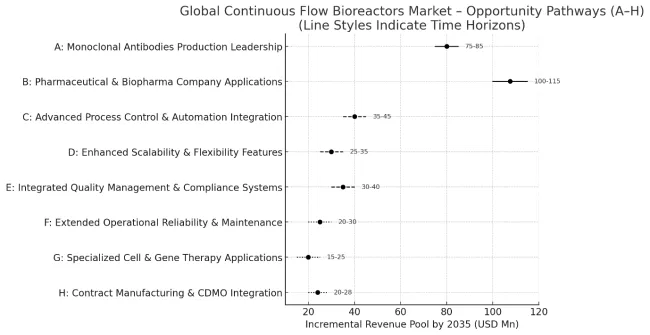
The continuous flow bioreactors market represents a rapidly emerging biotechnology opportunity at the intersection of biomanufacturing, pharmaceutical production, and advanced process control, with the market projected to expand from USD 160.3 million in 2025 to USD 558.8 million by 2035 at a robust 13.3% CAGR a 3.5X growth driven by accelerating biopharmaceutical demand, manufacturer preference for continuous production solutions, and the integration of advanced process control technology into scalable bioprocessing systems.
This convergence opportunity leverages the growing need for efficient biomanufacturing, the desire for scalable production during therapeutic development, and advances in continuous flow technology to create systems that offer superior production capabilities in a reliable, continuously operating format. Monoclonal antibodies lead with 47.5% market share due to their established production requirements and commercial viability, while pharmaceutical & biopharma companies dominate demand as manufacturers increasingly focus on improving production efficiency and scalability in therapeutic manufacturing. Geographic growth is strongest in developed markets where advanced biotechnology infrastructure and research spending support adoption of premium continuous flow systems.
Pathway A - Monoclonal Antibodies Production Leadership
The dominant application offers superior production scalability, consistent quality control, and proven therapeutic development essential for commercial applications. Companies developing advanced monoclonal antibody production systems with enhanced yield optimization, improved process control, and extended operational duration will capture the leading application segment. Expected revenue pool: USD 75-85 million.
Pathway B - Pharmaceutical & Biopharma Company Applications
The largest end-user segment benefits from growing focus on production efficiency and improving therapeutic development outcomes. Providers developing comprehensive biomanufacturing solutions with integrated process monitoring, regulatory compliance features, and scalability optimization will dominate this primary market. Opportunity: USD 100-115 million.
Pathway C - Advanced Process Control and Automation Integration
Next-generation systems require sophisticated bioprocess monitoring capable of optimizing production parameters with minimal operator intervention and maximum yield consistency. Companies investing in advanced automation algorithms, machine learning capabilities, and process validation will create competitive differentiation and premium positioning. Revenue uplift: USD 35-45 million.
Pathway D - Enhanced Scalability and Flexibility Features
Modern manufacturers require systems that support various production scales while providing consistent performance across different therapeutic applications. Developing products with improved modular designs, flexible configurations, and adaptable process parameters addresses growing manufacturing demands while reducing changeover complexity. Expected upside: USD 25-35 million.
Pathway E - Integrated Quality Management and Compliance Systems
Advanced products require seamless integration with quality control systems, regulatory reporting platforms, and manufacturing execution systems. Systems offering comprehensive compliance options, real-time quality monitoring, and automated documentation create enhanced value propositions for pharmaceutical manufacturers. USD 30-40 million.
Pathway F - Extended Operational Reliability and Maintenance Features
Manufacturers require confidence in system performance during extended production campaigns, especially for critical therapeutic production. Companies developing advanced predictive maintenance, system reliability features, and operational optimization capabilities will capture premium positioning opportunities. Pool: USD 20-30 million.
Pathway G - Specialized Cell and Gene Therapy Applications
Advanced therapeutics and personalized medicine represent growing opportunities for specialized bioreactor configurations. Developing tailored solutions for cell therapy production, gene therapy manufacturing, and personalized therapeutic applications expands beyond standard biopharmaceutical production. Expected revenue: USD 15-25 million.
Pathway H - Contract Manufacturing and CDMO Integration
Industry consolidation drives demand for solutions that enable efficient contract manufacturing and flexible production capabilities. Companies developing comprehensive contract manufacturing packages with technology transfer support, regulatory assistance, and production optimization will capture emerging market opportunities. Pool: USD 20-28 million.
Market expansion is being supported by the increasing global demand for biopharmaceutical products and the corresponding shift toward continuous manufacturing technologies that can provide superior production efficiency while meeting biotechnology requirements for scalability and process optimization capabilities. Modern pharmaceutical manufacturers and biotechnology companies are increasingly focused on incorporating continuous flow bioreactors to enhance production outcomes while satisfying demands for advanced bioprocessing technologies and efficient manufacturing systems. Continuous flow bioreactors' proven ability to deliver superior production scalability, consistent quality control, and operational efficiency makes them essential systems for therapeutic manufacturing and bioprocessing applications.
The growing emphasis on personalized medicine and advanced therapeutic development is driving demand for high-quality continuous flow bioreactor products that can support distinctive production experiences and comprehensive manufacturing capabilities across monoclonal antibody, cell therapy, and advanced therapeutic categories. Pharmaceutical manufacturer preference for systems that combine production excellence with process control capabilities is creating opportunities for innovative continuous flow implementations in both commercial manufacturing and development applications. The rising influence of regulatory compliance and quality assurance requirements is also contributing to increased adoption of premium continuous flow bioreactor products that can provide authentic manufacturing integration characteristics.
The market is segmented by application type and end user. The demand for application types is divided into monoclonal antibodies, cell & gene therapies, vaccines, and others. Based on end user, the market is categorized into pharmaceutical & biopharma companies, CMO and CDMOs, biotechnology companies, and others.
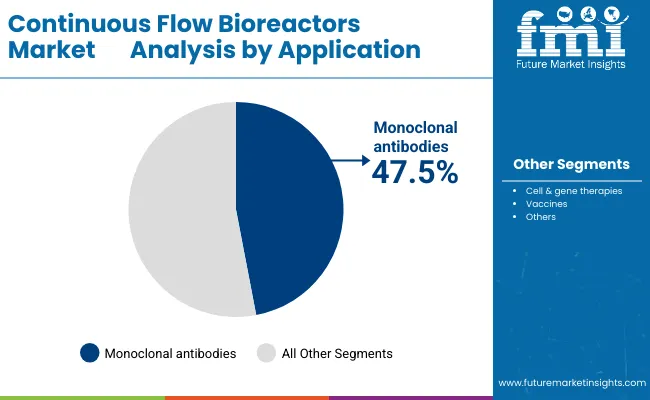
The monoclonal antibodies segment is projected to account for 47.5% of the continuous flow bioreactors market in 2025, reaffirming its position as the leading application category. Biotechnology manufacturers and pharmaceutical companies increasingly utilize monoclonal antibody production technology for their superior therapeutic efficacy, established development pathways, and proven commercial viability in continuous flow bioreactor applications across diverse manufacturing settings. Monoclonal antibody production technology's standardized processes and proven performance directly address the manufacturing requirements for consistent therapeutic development and reliable production scaling in continuous flow operations.
This application segment forms the foundation of modern biopharmaceutical manufacturing applications, as it represents the technology with the greatest commercial potential and established compatibility across multiple production systems. Manufacturer investments in process optimization and yield enhancement continue to strengthen adoption among biotechnology producers. With pharmaceutical companies prioritizing production efficiency and therapeutic effectiveness, monoclonal antibody production systems align with both commercial viability objectives and manufacturing scalability requirements, making them the central component of comprehensive continuous flow bioreactor strategies.
Cell & gene therapies follow with 26.3% market share, driven by increasing investment in advanced therapeutic development and growing regulatory approvals for personalized medicine applications. This segment benefits from expanding clinical pipeline and rising demand for innovative treatment modalities. Vaccines account for 3.5% of the market, supported by established production protocols and proven manufacturing scalability. Others category represents 22.7% market share, encompassing various therapeutic proteins and specialty biotechnology applications.
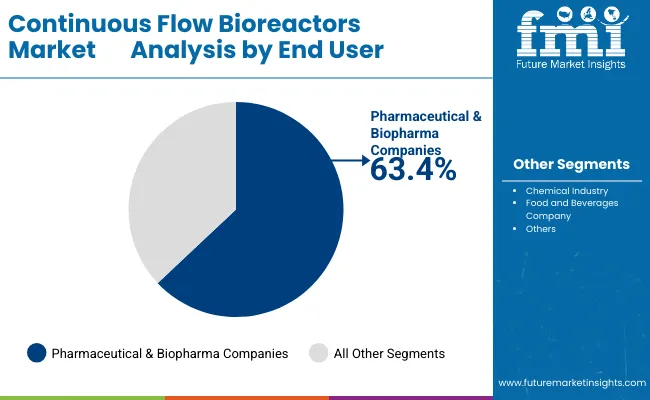
Pharmaceutical & biopharma companies are projected to represent the largest share of continuous flow bioreactors demand in 2025 at 63.4%, underscoring their critical role as the primary end user for advanced bioprocessing systems in therapeutic development and commercial manufacturing protocols. Pharmaceutical manufacturers and biotechnology companies prefer continuous flow bioreactor systems for their exceptional production capabilities, scalability features, and ability to maintain manufacturing efficiency while supporting regulatory compliance requirements during therapeutic production processes. Positioned as essential systems for commercial biomanufacturing, continuous flow bioreactors offer both production optimization and operational excellence advantages.
The segment is supported by continuous growth in biopharmaceutical development protocols and the growing availability of advanced continuous manufacturing technologies that enable enhanced production outcomes and cost reduction at the commercial manufacturing level. Additionally, pharmaceutical systems are investing in advanced bioprocessing technologies to support production efficiency improvement and manufacturing cost optimization. As biopharmaceutical development continues to evolve and manufacturers seek superior production solutions, pharmaceutical & biopharma companies will continue to dominate the end-user landscape while supporting technology advancement and manufacturing optimization strategies.
CMO and CDMOs follow with 21.1% market share, benefiting from increasing outsourcing trends and growing demand for flexible manufacturing capabilities. This segment is projected to grow to 23.0% by 2035, driven by pharmaceutical companies' focus on core competencies and capital efficiency. Biotechnology companies maintain 12.2% market share, supported by specialized therapeutic development and innovative manufacturing approaches. Others category represents 3.3% in 2025, declining to 0.0% by 2035 as the market consolidates around major end-user categories.
The continuous flow bioreactors market is advancing rapidly due to increasing biopharmaceutical production demand and growing adoption of continuous manufacturing solutions that emphasize superior production efficiency across commercial manufacturing and therapeutic development applications. However, the market faces challenges, including high capital investment costs compared to traditional batch processing alternatives, technical complexity in process optimization and scale-up, and competition from established batch production systems. Innovation in automation integration and process control enhancement continues to influence market development and expansion patterns.
The growing adoption of continuous flow bioreactors in comprehensive therapeutic production and advanced bioprocessing applications is enabling pharmaceutical manufacturers to develop protocols that provide distinctive production capabilities while commanding premium positioning and enhanced manufacturing outcome characteristics. Advanced manufacturing protocols provide superior efficiency while allowing more sophisticated therapeutic development across various product categories and application segments. Pharmaceutical systems are increasingly recognizing the competitive advantages of continuous flow manufacturing positioning for comprehensive production development and biotechnology specialty market penetration.
Modern continuous flow bioreactor suppliers are incorporating advanced process monitoring algorithms, machine learning systems, and predictive analytics technologies to enhance production efficiency, improve therapeutic outcomes, and meet pharmaceutical manufacturer demands for intelligent and reliable bioprocessing solutions. These programs improve system performance while enabling new applications, including personalized therapeutic production and predictive process optimization systems. Advanced AI integration also allows suppliers to support premium market positioning and manufacturing excellence leadership beyond traditional bioprocessing products.
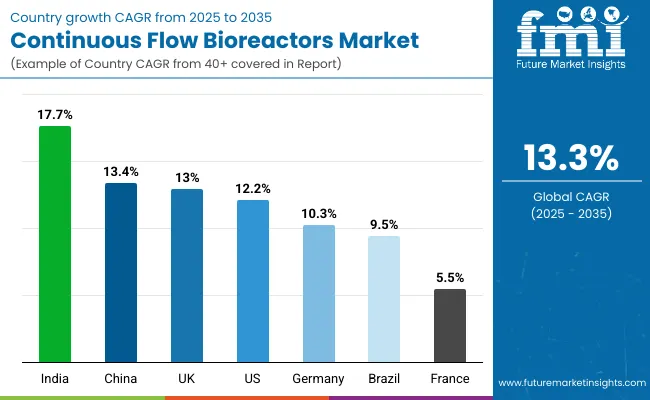
| Countries | CAGR (2025 to 2035) |
|---|---|
| India | 17.7% |
| South Korea | 14.4% |
| China | 13.4% |
| UK | 13.0% |
| USA | 12.2% |
| Germany | 10.3% |
| Brazil | 9.5% |
| France | 5.5% |
The continuous flow bioreactors market is experiencing exceptional growth globally, with India leading at a 17.7% CAGR through 2035, driven by expanding biotechnology infrastructure, rising pharmaceutical manufacturing capabilities, and increasing adoption of advanced bioprocessing technologies. South Korea follows at 14.4%, supported by growing biopharmaceutical investments, expanding research and development capabilities, and rising focus on advanced therapeutic manufacturing. China shows growth at 13.4%, emphasizing biotechnology sector expansion and expanding manufacturing capabilities.
The UK demonstrates 13.0% growth, prioritizing advanced biotechnology innovation and comprehensive biomanufacturing solutions. The USA records 12.2%, focusing on biopharmaceutical technology integration and production optimization. Germany exhibits 10.3% growth, supported by established pharmaceutical infrastructure and advanced bioprocessing adoption. Brazil demonstrates 9.5% growth, emphasizing biotechnology development and manufacturing expansion. France shows 5.5% growth, focusing on pharmaceutical technology advancement and high-quality bioprocessing solutions.
The report covers an in-depth analysis of 40+ countries; eight top-performing countries are highlighted below.
Revenue from continuous flow bioreactors in India is projected to exhibit exceptional growth with a CAGR of 17.7% through 2035, driven by expanding biotechnology infrastructure and rising awareness of advanced biomanufacturing across major pharmaceutical and biotechnology centers. The country's growing biotechnology sector and increasing adoption of continuous manufacturing technologies are creating substantial demand for continuous flow bioreactor solutions in both domestic pharmaceutical production and export-oriented manufacturing applications. Major biotechnology companies and pharmaceutical manufacturers are establishing comprehensive production and technical support capabilities to serve both Indian market needs and regional export opportunities.
Revenue from continuous flow bioreactors in South Korea is expanding at a CAGR of 14.4%, supported by growing biopharmaceutical investments, increasing biotechnology research capabilities, and expanding pharmaceutical manufacturing infrastructure with advanced bioprocessing capabilities. The country's developing biotechnology ecosystem and expanding pharmaceutical manufacturing sector are driving demand for sophisticated continuous flow bioprocessing systems across both established pharmaceutical facilities and emerging biotechnology centers. International biotechnology companies and domestic pharmaceutical manufacturers are establishing comprehensive production and technical support capabilities to address growing market demand for advanced bioprocessing solutions.
Revenue from continuous flow bioreactors in China is projected to grow at a CAGR of 13.4% through 2035, driven by biotechnology sector expansion initiatives, expanding pharmaceutical manufacturing capabilities, and growing focus on advanced therapeutic production requiring sophisticated bioprocessing solutions. China's developing biotechnology infrastructure and increasing emphasis on pharmaceutical manufacturing excellence are creating substantial demand for both standard and premium continuous flow bioreactor varieties. Leading biotechnology companies and pharmaceutical manufacturers are establishing comprehensive production strategies to serve both Chinese markets and growing regional manufacturing demand.
Revenue from continuous flow bioreactors in the United Kingdom is projected to grow at a CAGR of 13.0% through 2035, supported by the country's advanced biotechnology sector, innovation leadership capabilities, and established market for premium bioprocessing solutions. British pharmaceutical manufacturers and biotechnology companies prioritize manufacturing excellence, production efficiency, and technological advancement, making continuous flow bioreactors essential systems for both therapeutic development protocols and commercial manufacturing operations. The country's comprehensive biotechnology ecosystem and manufacturing adoption patterns support continued market development.
Revenue from continuous flow bioreactors in the United States is projected to grow at a CAGR of 12.2% through 2035, supported by the country's pharmaceutical innovation leadership, advanced biotechnology development sector, and established expertise in premium bioprocessing applications. American pharmaceutical manufacturers' focus on manufacturing excellence, production optimization, and technological innovation creates steady demand for intelligent bioprocessing products. The country's attention to regulatory compliance and production quality drives consistent adoption across both established pharmaceutical and emerging biotechnology applications.
Revenue from continuous flow bioreactors in Germany is projected to grow at a CAGR of 10.3% through 2035, supported by the country's manufacturing excellence priorities, advanced biotechnology development sector, and established focus on production quality and pharmaceutical innovation. German pharmaceutical manufacturers' emphasis on engineering excellence, production outcomes, and technology-centered manufacturing creates steady demand for advanced bioprocessing products. The country's attention to manufacturing quality and operational effectiveness drives consistent adoption across both established pharmaceutical and innovative biotechnology applications.
Revenue from continuous flow bioreactors in Brazil is projected to grow at a CAGR of 9.5% through 2035, supported by the country's biotechnology development sector, expanding pharmaceutical manufacturing capabilities, and established focus on manufacturing advancement while working to enhance bioprocessing capabilities and develop high-quality pharmaceutical technologies. Brazil's pharmaceutical industry continues to benefit from its manufacturing capabilities while focusing on biotechnology innovation and production advancement.
Revenue from continuous flow bioreactors in France is projected to grow at a CAGR of 5.5% through 2035, supported by the country's pharmaceutical technology integration initiatives, advanced biotechnology development sector, and established expertise in premium bioprocessing applications. French pharmaceutical manufacturers' focus on manufacturing excellence, production optimization, and technological integration creates steady demand for intelligent bioprocessing products. The country's attention to pharmaceutical quality and production effectiveness drives consistent adoption across both traditional pharmaceutical and emerging biotechnology applications.
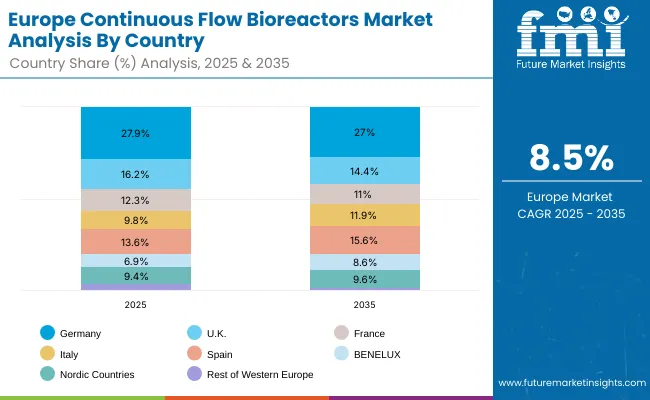
The continuous flow bioreactors market in Europe is projected to grow at a CAGR of 8.5% from 2025 to 2035. Germany is expected to maintain its leadership position with a 27.9% market share in 2025, declining slightly to 27.0% by 2035, supported by its precision biotechnology sector, advanced pharmaceutical infrastructure, and manufacturing capabilities serving regional and international markets.
The United Kingdom follows with a 16.2% share in 2025, projected to reach 14.4% by 2035, driven by priorities in advanced biotechnology development, manufacturing excellence, and innovation-based bioprocessing. France holds a 12.3% share in 2025, expected to maintain 11.0% by 2035, supported by pharmaceutical technology integration and biotechnology adoption, though facing challenges from competition and regulatory dynamics.
Italy accounts for 9.8% in 2025, projected to increase to 11.9% by 2035, while Spain contributes 13.6% in 2025, growing to 15.6% by 2035. The Nordic Countries represent 9.4% in 2025, maintaining 9.6% in 2035, while BENELUX holds 6.9% in 2025, growing to 8.6% by 2035. The Rest of Western Europe region is expected to account for 3.9% in 2025, declining to 1.9% by 2035, reflecting consolidation dynamics across smaller European markets.
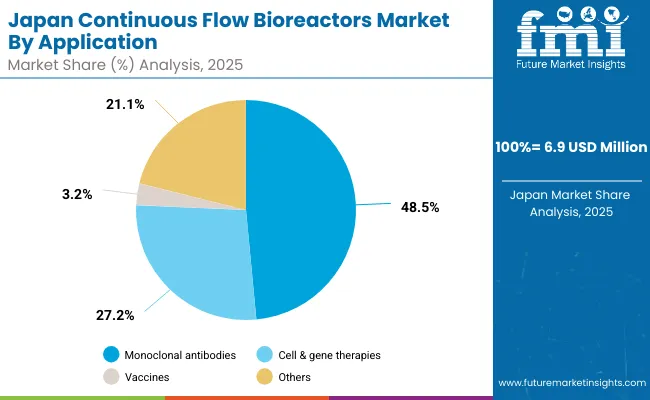
The continuous flow bioreactors market in Japan is projected to grow steadily from 2025 to 2035, supported by advanced pharmaceutical infrastructure, a strong biotechnology ecosystem, and adoption of continuous manufacturing technologies.
Monoclonal antibodies are expected to maintain their leadership position with a 48.5% market share in 2025, reflecting strong demand in therapeutic development and commercial manufacturing. Cell & gene therapies follow with 27.2% in 2025, supported by growing investment in advanced therapeutic applications and regulatory support for innovative treatments.
Vaccines hold 3.2% in 2025, supported by established production protocols and proven manufacturing scalability for immunization applications. Others account for 21.1% in 2025, representing various therapeutic proteins and specialty biotechnology manufacturing applications.
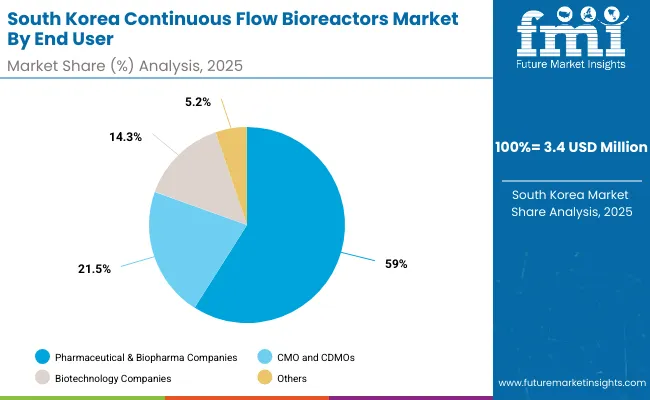
The continuous flow bioreactors market in South Korea is projected to expand through 2035, driven by increasing biopharmaceutical investments, strong pharmaceutical development capabilities, and growing adoption of continuous manufacturing processes.
Pharmaceutical & biopharma companies are expected to maintain their leadership with a 59.0% market share in 2025, supported by established therapeutic development programs and growing commercial manufacturing capabilities. CMO and CDMOs follow with 21.5% in 2025, reflecting South Korea's growing position as a regional manufacturing hub and increasing outsourcing trends.
Biotechnology companies account for 14.3% in 2025, supported by innovative therapeutic development and specialized manufacturing approaches. Others represent 5.2% in 2025, encompassing research institutions and emerging biotechnology applications.
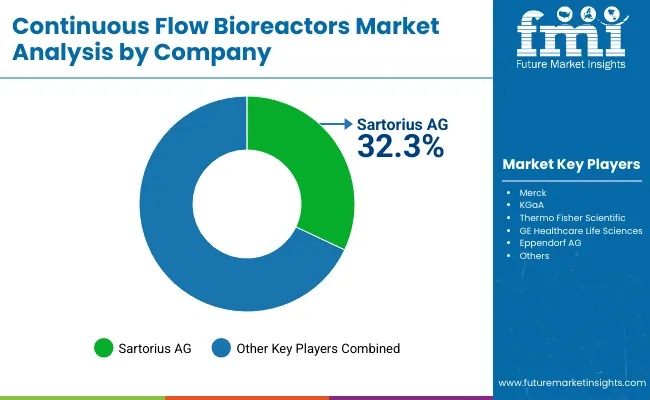
The continuous flow bioreactors market is characterized by competition among established biotechnology equipment companies, specialized bioprocessing manufacturers, and integrated pharmaceutical technology suppliers. Companies are investing in advanced process control technologies, production optimization systems, application-specific product development, and comprehensive technical support capabilities to deliver consistent, high-performance, and reliable continuous flow bioreactor products. Innovation in production efficiency enhancement, scalability improvement, and customized manufacturing compatibility is central to strengthening market position and pharmaceutical manufacturer satisfaction.
Sartorius AG leads the market with a dominant 32.3% share, focusing on comprehensive bioprocessing solutions and advanced biotechnology equipment, offering premium continuous flow bioreactor products with emphasis on manufacturing excellence and production optimization capabilities. Other key players provide specialized bioprocessing and manufacturing technologies with focus on innovation and technical support. Merck KGaA delivers integrated biotechnology solutions with emphasis on pharmaceutical system integration and operational excellence.
Thermo Fisher Scientific specializes in laboratory and manufacturing technologies with focus on production reliability and technical innovation. GE Healthcare Life Sciences focuses on bioprocessing equipment with emphasis on advanced system technology and manufacturing optimization. Eppendorf AG provides specialized bioprocessing solutions with focus on precision equipment and technical excellence.
| Items | Values |
|---|---|
| Quantitative Units (2025) | USD 160.3 million |
| Application Type | Monoclonal Antibodies, Cell & Gene Therapies, Vaccines, Others |
| End User | Pharmaceutical & Biopharma Companies, CMO and CDMOs, Biotechnology Companies, Others |
| Regions Covered | North America, Europe, East Asia, South Asia & Pacific, Latin America, Middle East & Africa |
| Countries Covered | United States, Canada, United Kingdom, Germany, France, China, Japan, South Korea, India, Brazil, Australia and 40+ countries |
| Key Companies Profiled | Sartorius AG, Merck KGaA, Thermo Fisher Scientific, GE Healthcare Life Sciences, Eppendorf AG, GEA Group Aktiengesellschaft, Getinge AB, Merck KGaA, PBS Biotech, Inc., Sartorius AG |
| Additional Attributes | Dollar sales by application type and end user, regional demand trends, competitive landscape, technological advancements in bioprocessing, pharmaceutical integration initiatives, production optimization programs, and manufacturing excellence enhancement strategies |
By North America
By Europe
By East Asia
By South Asia & Pacific
By Latin America
By Middle East & Africa
The global continuous flow bioreactors market is valued at USD 160.3 million in 2025.
The size for the continuous flow bioreactors market is projected to reach USD 558.8 million by 2035.
The continuous flow bioreactors market is expected to grow at a 13.3% CAGR between 2025 and 2035.
The key application type segments in the continuous flow bioreactors market are monoclonal antibodies, cell & gene therapies, vaccines, and others.
In terms of end user, pharmaceutical & biopharma companies segment is set to command 63.4% share in the continuous flow bioreactors market in 2025.






Our Research Products

The "Full Research Suite" delivers actionable market intel, deep dives on markets or technologies, so clients act faster, cut risk, and unlock growth.

The Leaderboard benchmarks and ranks top vendors, classifying them as Established Leaders, Leading Challengers, or Disruptors & Challengers.

Locates where complements amplify value and substitutes erode it, forecasting net impact by horizon

We deliver granular, decision-grade intel: market sizing, 5-year forecasts, pricing, adoption, usage, revenue, and operational KPIs—plus competitor tracking, regulation, and value chains—across 60 countries broadly.

Spot the shifts before they hit your P&L. We track inflection points, adoption curves, pricing moves, and ecosystem plays to show where demand is heading, why it is changing, and what to do next across high-growth markets and disruptive tech

Real-time reads of user behavior. We track shifting priorities, perceptions of today’s and next-gen services, and provider experience, then pace how fast tech moves from trial to adoption, blending buyer, consumer, and channel inputs with social signals (#WhySwitch, #UX).

Partner with our analyst team to build a custom report designed around your business priorities. From analysing market trends to assessing competitors or crafting bespoke datasets, we tailor insights to your needs.
Supplier Intelligence
Discovery & Profiling
Capacity & Footprint
Performance & Risk
Compliance & Governance
Commercial Readiness
Who Supplies Whom
Scorecards & Shortlists
Playbooks & Docs
Category Intelligence
Definition & Scope
Demand & Use Cases
Cost Drivers
Market Structure
Supply Chain Map
Trade & Policy
Operating Norms
Deliverables
Buyer Intelligence
Account Basics
Spend & Scope
Procurement Model
Vendor Requirements
Terms & Policies
Entry Strategy
Pain Points & Triggers
Outputs
Pricing Analysis
Benchmarks
Trends
Should-Cost
Indexation
Landed Cost
Commercial Terms
Deliverables
Brand Analysis
Positioning & Value Prop
Share & Presence
Customer Evidence
Go-to-Market
Digital & Reputation
Compliance & Trust
KPIs & Gaps
Outputs
Full Research Suite comprises of:
Market outlook & trends analysis
Interviews & case studies
Strategic recommendations
Vendor profiles & capabilities analysis
5-year forecasts
8 regions and 60+ country-level data splits
Market segment data splits
12 months of continuous data updates
DELIVERED AS:
PDF EXCEL ONLINE
Continuous Inkjet Inks Market Forecast and Outlook 2025 to 2035
Continuously Variable Transmission (CVT) Market Size and Share Forecast Outlook 2025 to 2035
Continuous Ambulatory Peritoneal Dialysis Bags Market Size and Share Forecast Outlook 2025 to 2035
Continuous Motion Cartoner Market Size and Share Forecast Outlook 2025 to 2035
Continuous Cardiac Monitoring Devices Market Size and Share Forecast Outlook 2025 to 2035
Continuous Ketone Monitoring Market Size and Share Forecast Outlook 2025 to 2035
Continuous Inkjet Printers Market Size and Share Forecast Outlook 2025 to 2035
Continuous Friction Tester Market Size and Share Forecast Outlook 2025 to 2035
Continuous Fryer Machine Market Size and Share Forecast Outlook 2025 to 2035
Continuous Glucose Monitoring Device Market - Demand & Future Trends 2025 to 2035
Continuous Hormone Monitoring Market Analysis - Size, Share, and Forecast Outlook 2025 to 2035
Continuous Emission Monitoring System Market Growth - Trends & Forecast 2025 to 2035
Continuous Positive Airway Pressure (CPAP) Market Analysis – Size, Share & Forecast Outlook 2025 to 2035
Continuous Glucose Monitoring Systems Market is segmented by transmitters and monitors, sensors and insulin pump from 2025 to 2035
Continuous Miners Market Growth - Trends & Forecast 2025 to 2035
Continuous Renal Replacement Therapy Market Growth – Trends & Forecast 2025-2035
Continuous Peripheral Nerve Block Catheter Market Growth – Trends & Forecast 2025-2035
Market Share Breakdown of Continuous Inkjet Printers Providers
Continuous Thread Metal Cap Market
Continuous Integration Tools Market

Thank you!
You will receive an email from our Business Development Manager. Please be sure to check your SPAM/JUNK folder too.
Chat With
MaRIA